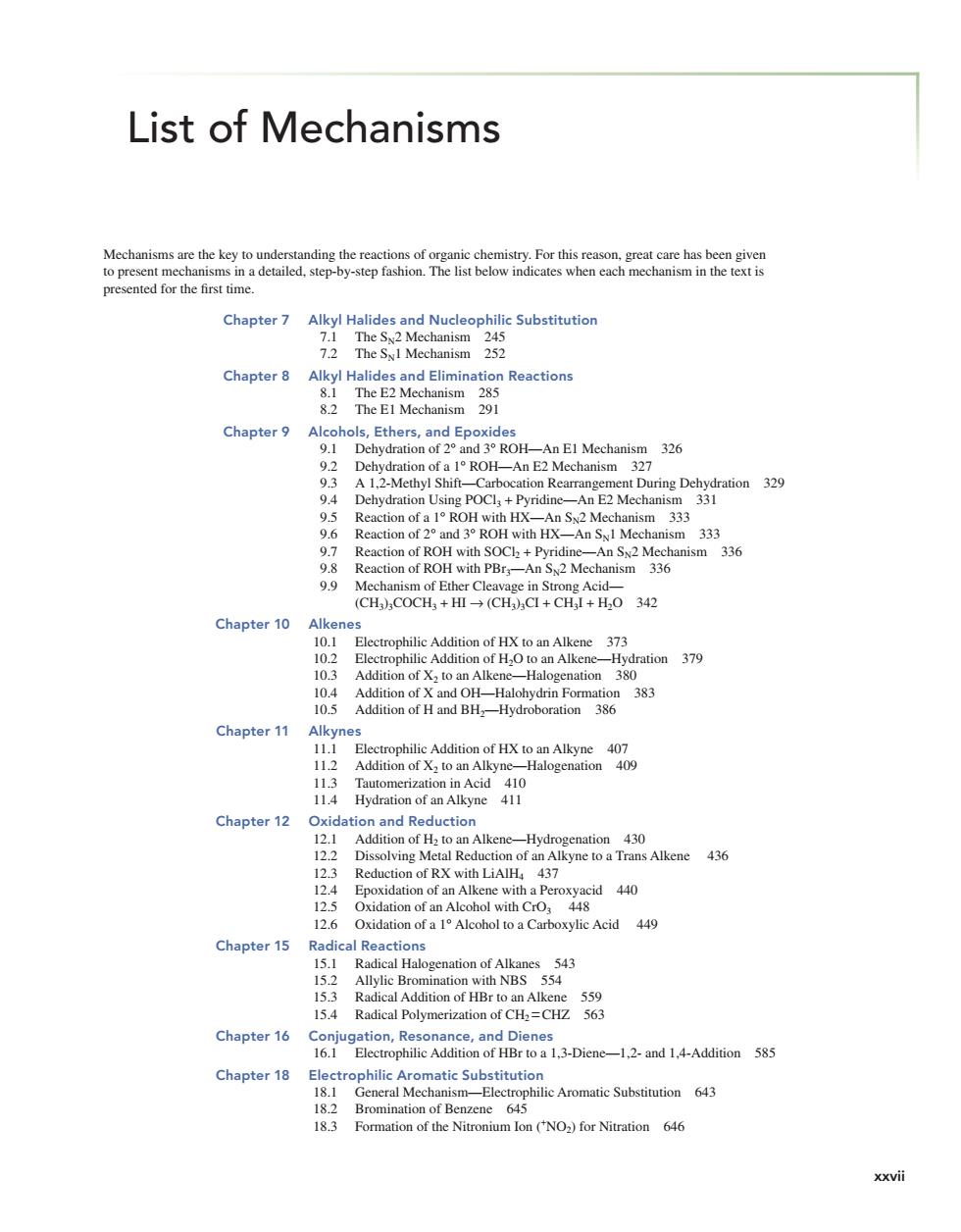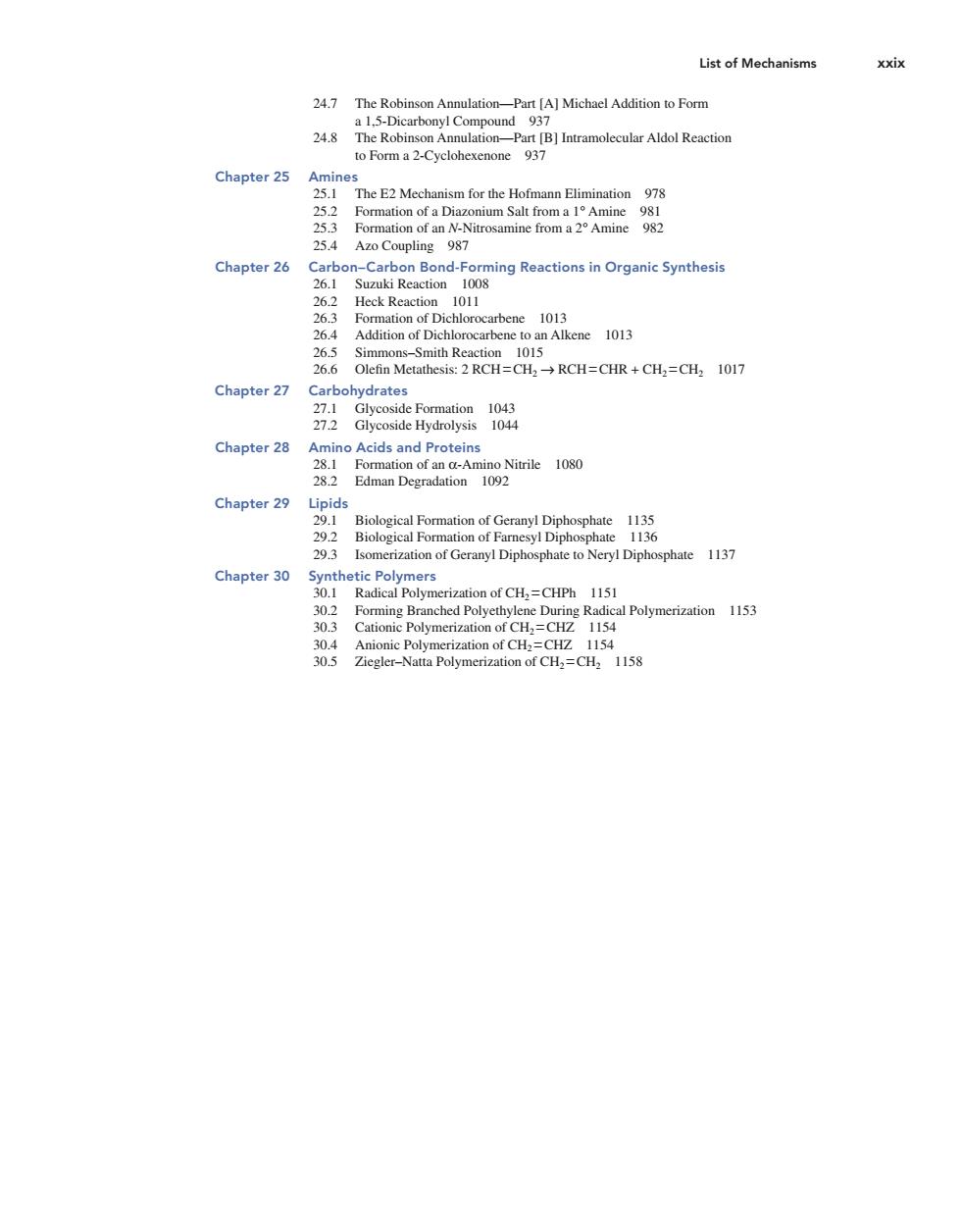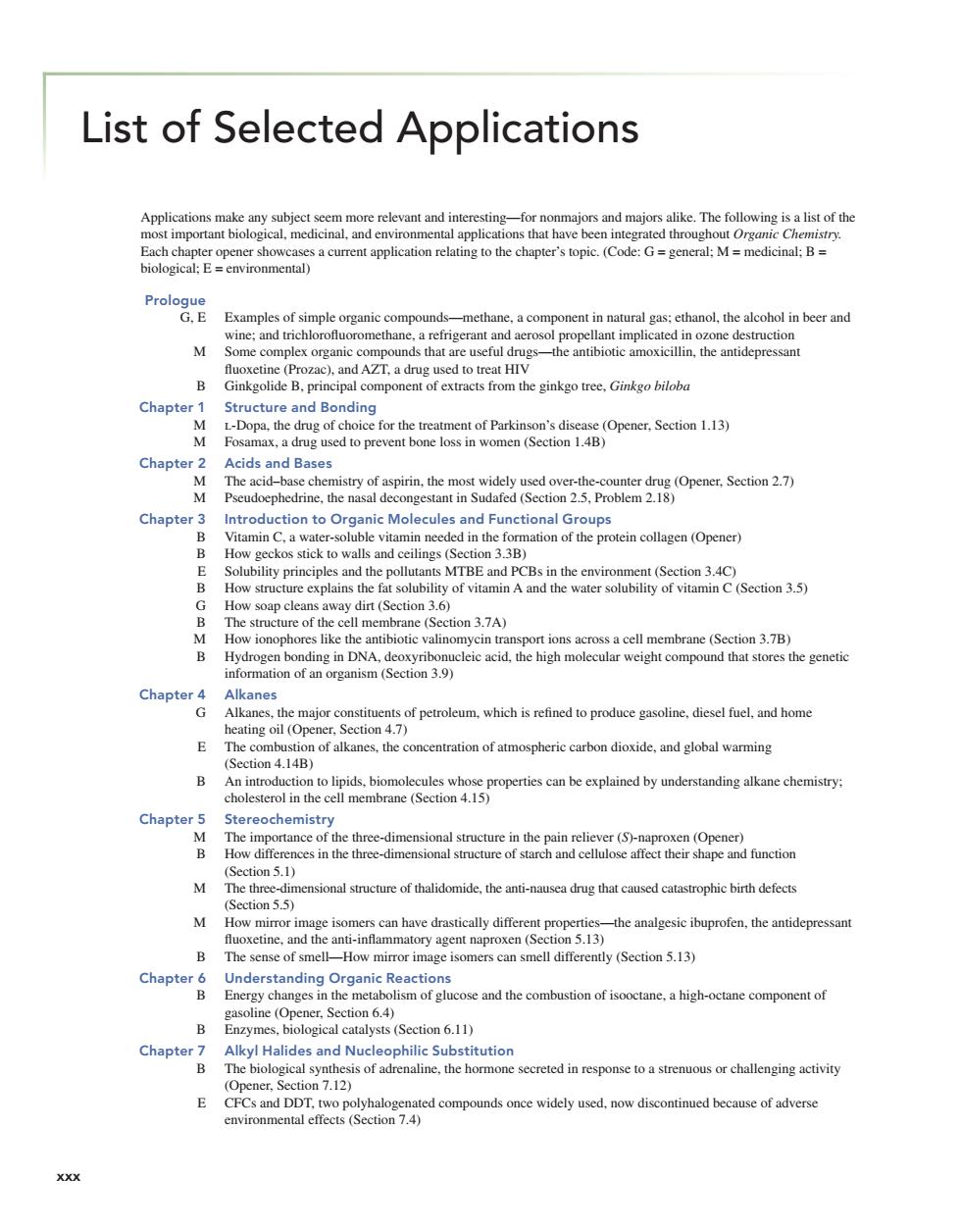
xxvi List of How To's Chapter 25 Amines Name and Amines with Different Alkyl Groups 952 Chapter 27 Hr Projection from n Acyclic Aldohexose1039 Chapter28
Chapter 25 Amines How To Name 2° and 3° Amines with Different Alkyl Groups 952 Chapter 27 Carbohydrates How To Draw a Haworth Projection from an Acyclic Aldohexose 1039 Chapter 28 Amino Acids and Proteins How To Use (R)-α-Methylbenzylamine to Resolve a Racemic Mixture of Amino Acids 1083 How To Synthesize a Dipeptide from Two Amino Acids 1095 How To Synthesize a Peptide Using the Merrifi eld Solid Phase Technique 1099 xxvi List of How To’s smi75625_fm_00i-xxxiv.indd xxvi 11/17/09 11:21:47 AM

List of Mechanisms Mechanism the ke has been presented for the first time. Chapter7 TicS、1 Mechanism252 and3°ROH -An EI Mechanism 326 A12-Mety shin chanism D Dehydration Using POCl+Pyridine An E2 Mechanis 9.9 Mechanism of Ether Cleav Acid- Chapter 10 373 ophicAdiiomoiHO an Alkene-Hydration379 on of X2 to an 383 Addition of Hand BH.Hydroboration of an Alkyne Chapter12 Alkene-Hydr nation 430 Dissolving Metal Redu n of an Alkyne to a Trans Alkene 436 e with a Peroxyacid40 44 Acid 449 Chapter 15 15.1 Radical Halogenation of Alkanes 4g NBS 9 15.4 Radical Polymerization of CH:=CHZ 563 183 Formation of the Nitronium Ion (NO2)for Nitration 646
List of Mechanisms xxvii Mechanisms are the key to understanding the reactions of organic chemistry. For this reason, great care has been given to present mechanisms in a detailed, step-by-step fashion. The list below indicates when each mechanism in the text is presented for the fi rst time. Chapter 7 Alkyl Halides and Nucleophilic Substitution 7.1 The SN2 Mechanism 245 7.2 The SN1 Mechanism 252 Chapter 8 Alkyl Halides and Elimination Reactions 8.1 The E2 Mechanism 285 8.2 The E1 Mechanism 291 Chapter 9 Alcohols, Ethers, and Epoxides 9.1 Dehydration of 2° and 3° ROH—An E1 Mechanism 326 9.2 Dehydration of a 1° ROH—An E2 Mechanism 327 9.3 A 1,2-Methyl Shift—Carbocation Rearrangement During Dehydration 329 9.4 Dehydration Using POCl3 + Pyridine—An E2 Mechanism 331 9.5 Reaction of a 1° ROH with HX—An SN2 Mechanism 333 9.6 Reaction of 2° and 3° ROH with HX—An SN1 Mechanism 333 9.7 Reaction of ROH with SOCl2 + Pyridine—An SN2 Mechanism 336 9.8 Reaction of ROH with PBr3—An SN2 Mechanism 336 9.9 Mechanism of Ether Cleavage in Strong Acid— (CH3)3COCH3 + HI → (CH3)3CI + CH3I + H2O 342 Chapter 10 Alkenes 10.1 Electrophilic Addition of HX to an Alkene 373 10.2 Electrophilic Addition of H2O to an Alkene—Hydration 379 10.3 Addition of X2 to an Alkene—Halogenation 380 10.4 Addition of X and OH—Halohydrin Formation 383 10.5 Addition of H and BH2—Hydroboration 386 Chapter 11 Alkynes 11.1 Electrophilic Addition of HX to an Alkyne 407 11.2 Addition of X2 to an Alkyne—Halogenation 409 11.3 Tautomerization in Acid 410 11.4 Hydration of an Alkyne 411 Chapter 12 Oxidation and Reduction 12.1 Addition of H2 to an Alkene—Hydrogenation 430 12.2 Dissolving Metal Reduction of an Alkyne to a Trans Alkene 436 12.3 Reduction of RX with LiAlH4 437 12.4 Epoxidation of an Alkene with a Peroxyacid 440 12.5 Oxidation of an Alcohol with CrO3 448 12.6 Oxidation of a 1° Alcohol to a Carboxylic Acid 449 Chapter 15 Radical Reactions 15.1 Radical Halogenation of Alkanes 543 15.2 Allylic Bromination with NBS 554 15.3 Radical Addition of HBr to an Alkene 559 15.4 Radical Polymerization of CH2 ––CHZ 563 Chapter 16 Conjugation, Resonance, and Dienes 16.1 Electrophilic Addition of HBr to a 1,3-Diene—1,2- and 1,4-Addition 585 Chapter 18 Electrophilic Aromatic Substitution 18.1 General Mechanism—Electrophilic Aromatic Substitution 643 18.2 Bromination of Benzene 645 18.3 Formation of the Nitronium Ion (+ NO2) for Nitration 646 smi75625_fm_00i-xxxiv.indd xxvii 11/17/09 11:21:47 AM

xxviii List of Mechanisms 184 647 18.6 888 Formation of th ctrophile in Fn -Cra A Rearrangement Re 65 Beginning with Chloride 65 Benzylic 070 Chapter20 arbonyl Chemistry:Organometallic Reagents; A Two-Step Process 724 2 20 LiAH Reduetion of RCHO and RC= 728 20 Reduction of RCOCI and RCOOR'with Metal Hydride Reagent 735 0 hilic Addition of r"mex to rcho a and R;C=O 743 208 ith RCOC 751 20. 1.2-Addition tonB-Unsatura te Carbonyl Compound 756 1,4-Ad ion to an o,p-Unsaturated Car nyl Compound Chapter 21 nyds and -Acid-Catalyzed Nuc The Witis Re 2 Imine Fo tone 798 803 cid- talyzed Additio H,O to a Cart yI Gro 80 Acetal Formation-Part [2]Formation of the Acetal 806 a Cyclic He romi 810 81 Chapter22 ylic Acids and Their Deriv General Mec ion ids 843 84d Acid-Catalyzed Con on of c rboxvlic Acids to Esters 848 ia.eionorC C boxyl Acidsto Amides wit h DC 29 Ba 221 Re 865 218Ra 89 ents (R-M)to Nitriles 866 Chapter23 Substitution React at the a carber 23 eid-Cat ed aBas t the c Ca 893 at theCarbon in Base 3 Chapter24 Rea 34 Dehydratio on of B-Hy apounds with Base 920 24.4 The Claisen Reaction 929 The bieckm 933 935
18.4 Formation of the Electrophile + SO3H for Sulfonation 647 18.5 Formation of the Electrophile in Friedel–Crafts Alkylation—Two Possibilities 649 18.6 Friedel–Crafts Alkylation Using a 3° Carbocation 649 18.7 Formation of the Electrophile in Friedel–Crafts Acylation 649 18.8 Friedel–Crafts Alkylation Involving Carbocation Rearrangement 651 18.9 A Rearrangement Reaction Beginning with a 1° Alkyl Chloride 651 18.10 Benzylic Bromination 670 Chapter 20 Introduction to Carbonyl Chemistry; Organometallic Reagents; Oxidation and Reduction 20.1 Nucleophilic Addition—A Two-Step Process 724 20.2 Nucleophilic Substitution—A Two-Step Process 725 20.3 LiAlH4 Reduction of RCHO and R2C–– O 728 20.4 Reduction of RCOCl and RCOOR' with a Metal Hydride Reagent 735 20.5 Reduction of an Amide to an Amine with LiAlH4 737 20.6 Nucleophilic Addition of R''MgX to RCHO and R2C–– O 743 20.7 Reaction of R''MgX or R''Li with RCOCl and RCOOR' 751 20.8 Carboxylation—Reaction of RMgX with CO2 754 20.9 1,2-Addition to an α,β-Unsaturated Carbonyl Compound 756 20.10 1,4-Addition to an α,β-Unsaturated Carbonyl Compound 756 Chapter 21 Aldehydes and Ketones—Nucleophilic Addition 21.1 General Mechanism—Nucleophilic Addition 786 21.2 General Mechanism—Acid-Catalyzed Nucleophilic Addition 787 21.3 Nucleophilic Addition of – CN—Cyanohydrin Formation 791 21.4 The Wittig Reaction 794 21.5 Imine Formation from an Aldehyde or Ketone 798 21.6 Enamine Formation from an Aldehyde or Ketone 800 21.7 Base-Catalyzed Addition of H2O to a Carbonyl Group 803 21.8 Acid-Catalyzed Addition of H2O to a Carbonyl Group 803 21.9 Acetal Formation—Part [1] Formation of a Hemiacetal 806 21.10 Acetal Formation—Part [2] Formation of the Acetal 806 21.11 Acid-Catalyzed Cyclic Hemiacetal Formation 810 21.12 A Cyclic Acetal from a Cyclic Hemiacetal 811 Chapter 22 Carboxylic Acids and Their Derivatives—Nucleophilic Acyl Substitution 22.1 General Mechanism—Nucleophilic Acyl Substitution 839 22.2 Conversion of Acid Chlorides to Anhydrides 843 22.3 Conversion of Acid Chlorides to Carboxylic Acids 843 22.4 Conversion of an Anhydride to an Amide 844 22.5 Conversion of Carboxylic Acids to Acid Chlorides 846 22.6 Fischer Esterifi cation—Acid-Catalyzed Conversion of Carboxylic Acids to Esters 848 22.7 Conversion of Carboxylic Acids to Amides with DCC 850 22.8 Acid-Catalyzed Hydrolysis of an Ester to a Carboxylic Acid 851 22.9 Base-Promoted Hydrolysis of an Ester to a Carboxylic Acid 852 22.10 Amide Hydrolysis in Base 856 22.11 Hydrolysis of a Nitrile in Base 864 22.12 Reduction of a Nitrile with LiAlH4 865 22.13 Reduction of a Nitrile with DIBAL-H 866 22.14 Addition of Grignard and Organolithium Reagents (R–M) to Nitriles 866 Chapter 23 Substitution Reactions of Carbonyl Compounds at the ` Carbon 23.1 Tautomerization in Acid 883 23.2 Tautomerization in Base 884 23.3 Acid-Catalyzed Halogenation at the α Carbon 893 23.4 Halogenation at the α Carbon in Base 894 23.5 The Haloform Reaction 895 Chapter 24 Carbonyl Condensation Reactions 24.1 The Aldol Reaction 918 24.2 Dehydration of β-Hydroxy Carbonyl Compounds with Base 920 24.3 The Intramolecular Aldol Reaction 927 24.4 The Claisen Reaction 929 24.5 The Dieckmann Reaction 933 24.6 The Michael Reaction 935 xxviii List of Mechanisms smi75625_fm_00i-xxxiv.indd xxviii 11/17/09 11:21:47 AM

list of Mechanisms xxix 24.7 The Robinson Annulation-Part [A]Michael Addition to Form 24.8 Chapter 25 Amine The E2 Me Azo Coupling Chapter 26 ming Reactions in Organic Synthesis 61 6 Heck Reactio 1011 264 265 RCH=CHR+CH,=CH2 1017 Chapter 27 27.1 Glycoside Formation 1043 27. Glycoside Hydrolysis 104 Chapter 28 283 1080 Chapter 29 Lipid of Geranyl Diphosphate 1135 29.3 somerization of Geranyl Diphosphate to Neryl Diphosphate 1137 Chapter 30 Synthetic Polymers Radical ion of CH2=CHP 115 Polymerization 1153 30.3 Anioni 1158
List of Mechanisms xxix 24.7 The Robinson Annulation—Part [A] Michael Addition to Form a 1,5-Dicarbonyl Compound 937 24.8 The Robinson Annulation—Part [B] Intramolecular Aldol Reaction to Form a 2-Cyclohexenone 937 Chapter 25 Amines 25.1 The E2 Mechanism for the Hofmann Elimination 978 25.2 Formation of a Diazonium Salt from a 1° Amine 981 25.3 Formation of an N-Nitrosamine from a 2° Amine 982 25.4 Azo Coupling 987 Chapter 26 Carbon–Carbon Bond-Forming Reactions in Organic Synthesis 26.1 Suzuki Reaction 1008 26.2 Heck Reaction 1011 26.3 Formation of Dichlorocarbene 1013 26.4 Addition of Dichlorocarbene to an Alkene 1013 26.5 Simmons–Smith Reaction 1015 26.6 Olefi n Metathesis: 2 RCH ––CH2 ã RCH ––CHR + CH2 ––CH2 1017 Chapter 27 Carbohydrates 27.1 Glycoside Formation 1043 27.2 Glycoside Hydrolysis 1044 Chapter 28 Amino Acids and Proteins 28.1 Formation of an α-Amino Nitrile 1080 28.2 Edman Degradation 1092 Chapter 29 Lipids 29.1 Biological Formation of Geranyl Diphosphate 1135 29.2 Biological Formation of Farnesyl Diphosphate 1136 29.3 Isomerization of Geranyl Diphosphate to Neryl Diphosphate 1137 Chapter 30 Synthetic Polymers 30.1 Radical Polymerization of CH2 ––CHPh 1151 30.2 Forming Branched Polyethylene During Radical Polymerization 1153 30.3 Cationic Polymerization of CH2 ––CHZ 1154 30.4 Anionic Polymerization of CH2 ––CHZ 1154 30.5 Ziegler–Natta Polymerization of CH2 ––CH2 1158 smi75625_fm_00i-xxxiv.indd xxix 11/17/09 11:21:48 AM

List of Selected Applications Proloummte alo in fluoxetine (Pro)and .rused to Ginkgolide B.principal component of extracts from the ginkgo Chapter Structure and Bonding (Opener.Section 1.13 Chapter 2 Acids and Bases Chapte nic Mol tion 3.3B) Section 3.4C s away dirt (Section.7A) 日ot ocin omen女e7汤 cleic acid,the high molecular weight compound that stores the genetic Chapter4 Alkanes G Alkanes.the major constituents of petroleum.which is refined to produce gasoline.diesel fuel.and home E entration of atmospheric carbon dioxide.and global warmine (Section4.14B】 B be explained by understanding alkane chemistry Chapter5 Stereochemistry (Section 5.1) How mirror imag s-the anagesic ibuprofen,the antidepressant uine.and t innamm The se mell diffe 山y(Section5.l3) Chapter B im(Section 611) Chapter7 Alkyl Halide The biological s synth ted co nds once widely used,now discontinued because of adverse environmental effects (Section 7.)
List of Selected Applications Prologue G, E Examples of simple organic compounds—methane, a component in natural gas; ethanol, the alcohol in beer and wine; and trichlorofl uoromethane, a refrigerant and aerosol propellant implicated in ozone destruction M Some complex organic compounds that are useful drugs—the antibiotic amoxicillin, the antidepressant fl uoxetine (Prozac), and AZT, a drug used to treat HIV B Ginkgolide B, principal component of extracts from the ginkgo tree, Ginkgo biloba Chapter 1 Structure and Bonding M l-Dopa, the drug of choice for the treatment of Parkinson’s disease (Opener, Section 1.13) M Fosamax, a drug used to prevent bone loss in women (Section 1.4B) Chapter 2 Acids and Bases M The acid–base chemistry of aspirin, the most widely used over-the-counter drug (Opener, Section 2.7) M Pseudoephedrine, the nasal decongestant in Sudafed (Section 2.5, Problem 2.18) Chapter 3 Introduction to Organic Molecules and Functional Groups B Vitamin C, a water-soluble vitamin needed in the formation of the protein collagen (Opener) B How geckos stick to walls and ceilings (Section 3.3B) E Solubility principles and the pollutants MTBE and PCBs in the environment (Section 3.4C) B How structure explains the fat solubility of vitamin A and the water solubility of vitamin C (Section 3.5) G How soap cleans away dirt (Section 3.6) B The structure of the cell membrane (Section 3.7A) M How ionophores like the antibiotic valinomycin transport ions across a cell membrane (Section 3.7B) B Hydrogen bonding in DNA, deoxyribonucleic acid, the high molecular weight compound that stores the genetic information of an organism (Section 3.9) Chapter 4 Alkanes G Alkanes, the major constituents of petroleum, which is refined to produce gasoline, diesel fuel, and home heating oil (Opener, Section 4.7) E The combustion of alkanes, the concentration of atmospheric carbon dioxide, and global warming (Section 4.14B) B An introduction to lipids, biomolecules whose properties can be explained by understanding alkane chemistry; cholesterol in the cell membrane (Section 4.15) Chapter 5 Stereochemistry M The importance of the three-dimensional structure in the pain reliever (S)-naproxen (Opener) B How differences in the three-dimensional structure of starch and cellulose affect their shape and function (Section 5.1) M The three-dimensional structure of thalidomide, the anti-nausea drug that caused catastrophic birth defects (Section 5.5) M How mirror image isomers can have drastically different properties—the analgesic ibuprofen, the antidepressant fl uoxetine, and the anti-infl ammatory agent naproxen (Section 5.13) B The sense of smell—How mirror image isomers can smell differently (Section 5.13) Chapter 6 Understanding Organic Reactions B Energy changes in the metabolism of glucose and the combustion of isooctane, a high-octane component of gasoline (Opener, Section 6.4) B Enzymes, biological catalysts (Section 6.11) Chapter 7 Alkyl Halides and Nucleophilic Substitution B The biological synthesis of adrenaline, the hormone secreted in response to a strenuous or challenging activity (Opener, Section 7.12) E CFCs and DDT, two polyhalogenated compounds once widely used, now discontinued because of adverse environmental effects (Section 7.4) xxx Applications make any subject seem more relevant and interesting—for nonmajors and majors alike. The following is a list of the most important biological, medicinal, and environmental applications that have been integrated throughout Organic Chemistry. Each chapter opener showcases a current application relating to the chapter’s topic. (Code: G = general; M = medicinal; B = biological; E = environmental) smi75625_fm_00i-xxxiv.indd xxx 11/19/09 9:28:03 AM